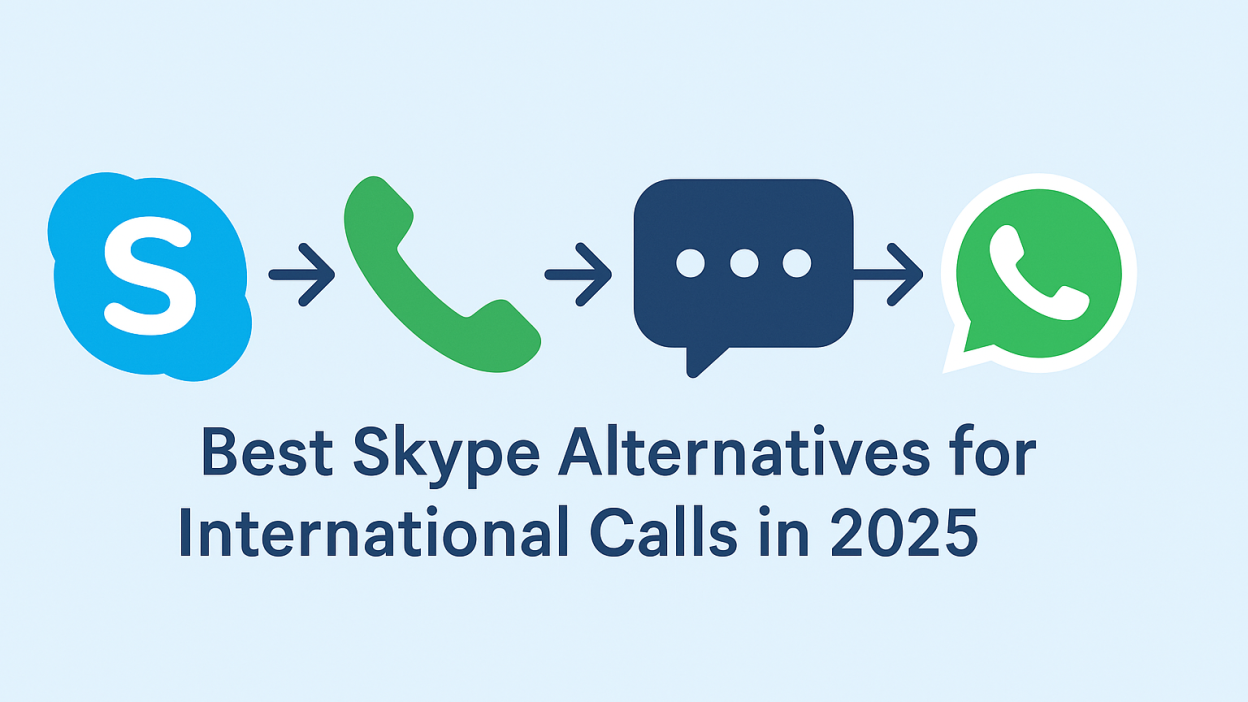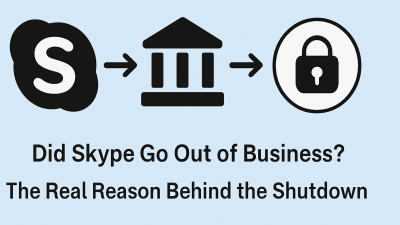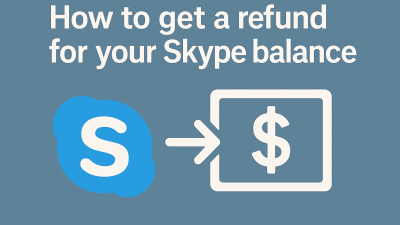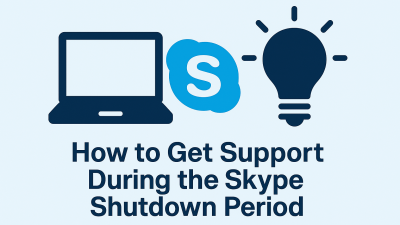When Skype first showed up, it gave people something powerful: a way to stay close to people who were far away, without draining their wallets. It wasn’t about branding or ecosystems or integrations. It was about voice. Presence. Connection.
Now, with Skype shutting down, millions are searching for a replacement. Not for meetings or group projects. Just something that lets them dial a number halfway around the world, hear a familiar voice, and know it won’t cost half a paycheck.
The problem is, most of what’s being recommended isn’t designed for that. Microsoft Teams is too layered. Zoom is built for video meetings. WhatsApp is fine for chatting, but not for calling real phone numbers. Google Voice? Great if you live in the U.S. and don’t need to call anyone outside North America.
So, where does that leave you?
If your goal is international calls, real ones, to real numbers, without apps or upgrades, you need a tool that was built for that job.
Why Skype Mattered — and Why Its End Leaves a Gap
Skype worked because it didn’t ask much of you. You could use it from an old desktop, a flip phone, or a café connection. It supported people living across time zones and currencies. You didn’t need to convince your aunt to install something, you just dialed her landline.
It also gave people control. You paid only for what you used. If you had $5 in credit, that was enough to talk for hours, depending on the country. It was a model that worked for students, expats, freelancers, and families stretched across continents.
With Skype shutting down, that model disappears, unless you go looking for something built in the same spirit.
What Today’s Alternatives Get Wrong About International Calling
Scroll through most “best alternatives to Skype” lists, and you’ll start seeing the same names repeated. Zoom. Teams. WhatsApp. Viber. Webex. They sound modern. But almost none of them solve the core problem people are facing.
They expect you to:
-
Call only other users on the same app
-
Set up accounts before making a single call
-
Accept patchy call quality depending on internet speeds
-
Navigate pricing tiers designed for companies, not people
-
Give up on calling landlines or basic mobile phones altogether
That’s not a solution. That’s a redesign of the problem, one that makes calling harder, not easier.
What you need instead is a platform that focuses on the one thing you actually care about: letting you make affordable, reliable calls to anyone, anywhere, whether or not they use an app.
The Quiet Power of a Purpose-Built Solution: Enter MyTello
Most people haven’t heard of MyTello yet. That’s because it wasn’t built for headlines or hype. It was built for calling, plain and simple.
And that’s exactly why it works.
MyTello doesn’t ask you to rethink how calling should work. It gives you a number, a dial pad, and clear pricing. You can use it from your phone, your computer, or even a landline. You don’t need to explain anything to the person on the other end. You call. They pick up. That’s it.
Where others pile on features and integrations, MyTello strips everything back to what matters.
How MyTello Handles the Job Skype Used to Own
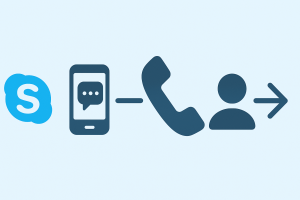
Three things make MyTello stand out, not as a tech product, but as a communication tool people can use.
1. It’s Built for Real-World Calling
You don’t need the person you’re calling to have a smartphone, internet, or an app. You can call their landline or mobile phone in over 200 countries. That opens the door for grandparents, small businesses, or friends in remote areas who’ve never used a messaging app in their lives.
You can also make calls from your own landline if needed, a feature most “modern” apps don’t even consider.
2. It’s Transparent and Pay-as-You-Go
There are no contracts. No bundles. You load your account with as much or as little credit as you want, and pay only for the time you use. Rates are listed clearly before each call. You can test the service for free. You know exactly what you’re getting into.
That’s a rare thing in a world where most apps hide their costs until you’ve signed up.
3. It Works in Bad Conditions
MyTello isn’t built just for perfect Wi-Fi. It’s optimized for patchy connections, older phones, and unpredictable environments. If you’ve ever tried to make a call from rural Kenya or a metro station in India, you know how valuable that is.
Skype earned loyalty by being stable. MyTello earns it by being dependable.
Why MyTello Isn’t Just Another Name on a List
This isn’t a roundup. You won’t find a long string of company names here with feature comparisons and star ratings. That’s because if you’ve come looking for a Skype alternative in 2025, chances are, you don’t want 20 new options. You want one that actually works.
MyTello is one of the few services that has picked up where Skype left off, not in name, but in function. It doesn’t try to be your calendar, your team hub, your document viewer. It just helps you call people.
And sometimes, that’s more than enough.
Not All “Alternatives” Are Built the Same
Since Skype’s shutdown announcement, there’s been no shortage of lists offering up replacements. But most of them are written from a software angle, not a user one. They focus on integrations, features, and tech specs.
The truth is, most people looking for a Skype alternative aren’t shopping for a product suite. They want a tool that lets them make international calls the way they’ve always done, directly, affordably, and without confusion.
That’s the lens we’re using here.
How the Top Alternatives Stack Up Against MyTello
You’ll hear these names a lot in forums, blog posts, and “best of” lists. But how do they actually perform when international calling is your only goal?
We’ve broken it down not by marketing claims, but by how each platform handles the real-world needs Skype users are now facing.
Google Voice
Who it’s good for: U.S.-based users calling domestically or occasionally to Canada
Where it falls short:
-
International calling is limited and not well-supported in most regions
-
Requires a U.S. phone number to even get started
-
Not built for global flexibility — feels like a secondary feature
If you’re calling outside the U.S., especially regularly, Google Voice isn’t built for that job.
Who it’s good for: App-to-app communication among people who are already on WhatsApp
Where it falls short:
-
You can’t call someone’s phone number if they don’t have WhatsApp
-
No way to reach landlines or people with no internet access
-
Call quality depends entirely on the internet strength of both users
WhatsApp is free, yes — but it’s not a phone replacement. It’s a chat tool with calling as a side feature. Great for social circles, not for international outreach.
Zoom Phone
Who it’s good for: Companies already using Zoom as their daily video platform
Where it falls short:
-
Pricing designed for teams, not individuals
-
Setup process is too complex for personal or occasional users
-
Limited use unless you’re already in a paid Zoom ecosystem
Zoom Phone wasn’t designed for quick calls to someone abroad. It’s part of a larger enterprise product stack. If you’re just trying to call a number in another country, you’ll find yourself navigating a lot of extra steps.
Viber
Who it’s good for: Messaging with free app-to-app calling
Where it falls short:
-
Viber Out (their calling service) is often overlooked and inconsistent in quality
-
Requires both users to be active in the app for best results
-
Still very app-centric, no landline or basic mobile support without extra steps
Viber has been around nearly as long as Skype, but it’s primarily used in certain regions. If your contacts aren’t on it already, it’s not the easiest shift.
Talk360
Who it’s good for: People focused solely on international calls
Where it falls short:
-
Not as globally consistent in pricing or support
-
Some users report issues with call quality and billing
-
Not as mature or user-tested as platforms like MyTello
Talk360 is on the right track in terms of goals, but it still lacks the polish and reliability many Skype users are used to. MyTello simply feels more dependable.
OpenPhone, Zadarma, and Other VOIP Startups
Who they’re for: Entrepreneurs, remote teams, niche users needing call routing or business numbers
Where they fall short:
-
Too complex for personal use
-
Pricing is often geared toward companies, not individuals
-
Steeper learning curves and interfaces that assume a high level of comfort with telecom systems
These are good tools if you’re building a call center. They’re not ideal if you’re just calling your sister in the Philippines or your accountant in Poland.
Where MyTello Still Holds the Edge

Across all these comparisons, MyTello stands out not because it tries to do everything, but because it does one thing well: it helps you make simple, affordable, no-hassle calls to people who aren’t always online or tech-savvy.
-
It doesn’t ask your mom to install an app
-
It doesn’t assume you’re running a business
-
It doesn’t try to become your all-in-one communication tool
It just makes calls. Clearly. Cheaply. Reliably.
That kind of focus is rare now, and valuable.
Who MyTello Serves Best
This section is about helping readers see themselves and their situations in the product.
Expats and Immigrants
If your family lives abroad and you need a way to stay in touch regularly, MyTello offers stable, low-cost calling without needing your relatives to install anything new or figure out a smartphone.
Freelancers and Remote Workers
If you’re working with clients across borders and want to keep business calls separate from your mobile plan, MyTello gives you control over costs and usage, without needing a virtual office.
Aging Parents or Tech-Averse Family Members
When you’re calling someone who still uses a flip phone or doesn’t trust apps, MyTello works where app-to-app services can’t. It respects simplicity and meets people where they are.
Travelers and Nomads
Even when you’re on the move, you can call landlines and mobile numbers from a web browser or local number, no need to swap SIMs or juggle accounts. It adapts with you.
Choosing What’s Right for You
Every tool has its place. But if your goal is to replace the practical, no-nonsense voice function that Skype offered, without dragging in extra software, logins, or subscriptions, MyTello is one of the few platforms left that fills that role.
The big platforms are optimizing for meetings, not phone calls. They’re building ecosystems, not direct links. And most of them will make you jump through hoops before you hear the first ring.
What matters most is this: the tool you choose should disappear into the background. It should let you focus on the person you’re calling, not the platform you’re using.
If that’s what you’re looking for, MyTello is already doing the job Skype used to do, and in many ways, doing it better.
Final Thoughts: Simple Calling Still Matters
As the tech world moves faster and platforms grow heavier, simple international calling has become harder to find. But that need hasn’t gone away. People still want to talk — clearly, directly, and affordably.
MyTello isn’t trying to replace Zoom or Slack, or WhatsApp. It’s here for the people who just want to dial a number and hear someone’s voice.
And that might be the most valuable feature of all.

